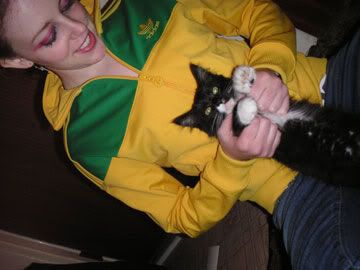Last week I finished reading Skinny Legs and All by Tom Robbins. OH, WHAT A BOOK. As quoth by Playboy on the back cover, it is "flat-out fabulous." Dear readers, I read Still Life with Woodpecker by Robbins last year, and loved it also. Both books are like crack. Well, what I imagine literary crack to be, anyway: forever relevant, full of allusions, and impossible to put down! As in Still Life, I encountered the following in Skinny Legs: an engaging plot, strong female characters, a whole lot of randomness, and graphic sex scenes.
It goes without saying I will read all of Robbins' books.
It goes without saying I will read all of Robbins' books.
Skinny Legs chronicles the cross-country adventure of Ellen Cherry Charles and her new hubby, Boomer... in a large turkey. Ellen Cherry is an educated artist, and Boomer is the fool who created the turkey out of an Airstream trailer, not realizing until later it was "art." Naturally, a question asked by the book is: how do we define art?
But that's not the only question. Another important one is: How do we solve the Israel-Palestine conflict (adding to that—can we)? Naturally, we get a lot of great discussion about this through a Jew and Arab who open a Middle Eastern restaurant together.
But that's not the only question. Another important one is: How do we solve the Israel-Palestine conflict (adding to that—can we)? Naturally, we get a lot of great discussion about this through a Jew and Arab who open a Middle Eastern restaurant together.
Another shocking thing: inanimate objects are capable of locomotion—most just don't know how. But if you've ever wanted to follow a devout Christian spoon, a transsexual Can O'Beans, and a sensual conch shell around New York City, this is your book! In addition to these colorful characters, we also meet Ellen's parents and her uncle, a fire-and-brimstone preacher hell-bent on summoning the Third Coming. Many of these characters start out in Colonial Pines, Virginia; move to NYC; and end up in Jerusalem.
Speaking of the fertile crescent, the title Skinny Legs and All is in reference to Salome, the Biblical temptress who entertained her stepfather Herod, for which she received a gift of her choice—which happened to be the head of John the Baptist. She is considered a jezebel (not to be confused with the ill-regarded biblical Jezebel) because she danced salaciously for Herod, removing seven veils (something Robbins uses as a plot device in multiple ways) to expose her underage flesh. THAT IS MY IDEA OF A GOOD TIME (if I were a king, not a Kristina King). Anyway, this biblical/Robbinsian Salome has skinny legs. BAM! WE HAVE A TITLE!
So, the Seven Veils thing: Babylonian lore tells us that Ishtar visited the underworld (it's like Enchanted Forest for the gods), and had to remove one piece of clothing for each gate she stepped through; Salome merely adapted that ritual for her depraved dance. A character in the book dances the said cha-cha-cha, lowering veils to expose her flesh, and ultimately, reality. Too bad so many men chose The Super Bowl over the dance!
The dance, the lowering of the veils and raising of our consciousness, is when Robbins is at his best. His characters, particularly Ellen Cherry, learn what really matters in life (it is not politics, religion, money...well, there are seven veils). For the readers, this may be an eloquent reminder (457):
And this further thought occurred to Ellen Cherry after the falling aside of Salome's first veil: that whenever society demonstrated signs of rediscovering the goddess, or returning to more feminine values systems, the patriarchally conditioned psyche generated diseases, literal diseases such as syphilis in the hotly romantic nineteenth century and, in the wake of the Sexual Revolution of the 1960s, AIDS. Those diseases were caused not by sexual license but by the fear of sexual license; by the conservative DNA's inability to adjust to hedonism; and they were compounded by guilt over the suppression of the Great Mother and the denial of the sensuality with which she so frequently underscored her coexistence with the void.
Or, it might be mind-blowing (460):
-KK
The monkey wrench in the progressive machinery of primate evolution was the propensity of the primate band to take its political leaders—its dominant males—too seriously. Of benefit to the band only when it was actively threatened by predators, the dominant male (or political boss) was almost wholly self-serving and was naturally dedicated not to liberation but to control. Behind his chest-banging and fang display, he was largely a joke and could be kept in his place (his place being that of a necessary evil) by disrespect and laughter. If, for example, when Hitler stood up to rant in the beer halls of Munich, the good drinkers had taken him more lightly, had they, instead of buying his act, snickered and hooted and pelted him with sausage skins, the Holocaust might have been avoided.I bet you saw this coming: I highly recommend this novel.
-KK
P.S. Next up is Dune, because it was thrust in my pants whilst dancing to "Love is a Battlefield" at '80s Night.
